L&J Development and Consultancy
Back to
![]() Special Tours for Journalists in April-May
2007
Special Tours for Journalists in April-May
2007
Andrew Salmon, Seoul correspondent for Washington Times, visited North Korea in October 2005..
At 2:30AM, the streets of Pyongyang are largely unlit, almost silent, and
virtually empty. A cough echoes across the broad, dark boulevards. A couple
walks surreptitiously by, arm in arm, almost invisible in the shadows under the
trees that line the road. In the only business open, a kiosk selling sweet
potatoes, a brown-uniformed serving woman snores on the counter. In the rare
patches of light, portraits of the Great Leader and the Dear Leader beam
benevolently from their illuminated alcoves.
With their daytime schedules being tightly controlled, a group of 17 journalists
and authors – including six from Seoul - who visited the secretive state in
October 2005 on a rare media tour organized by L&J DEVELOPMENT and CONSULTANCY for the Arirang Mass Games found that the only
time they could wander freely was to slip out of their hotel after midnight.
But in Pyongyang, is one ever unobserved? This reporter was startled when an invisible loudspeaker, droning unintelligible Korean from a pitch-black side street, suddenly burst into “Hello, hello!” as he returned to his hotel.
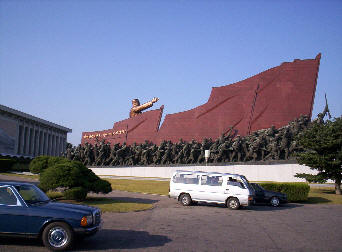 |
Having covered North Korea from Seoul for over two years, it was quite an
experience being in “Kim’s Kingdom” at last. In many ways, Pyongyang, our
primary destination, is a beautiful city. Imagine an Asian capital with no air
pollution, no traffic lights and no traffic jams. That’s Pyongyang - possibly
the last place left East of Suez where driving is a pleasure. The broad streets
are so sparsely populated by motor vehicles that in five days, I don’t recall
our tour bus having to stop once. |
If Seoul is a capital of capitalism, Pyongyang is a monument to monumentalism:
Like ancient Rome, this is a city designed to awe foreign barbarians and local
provincials. It succeeds. Kim Il-sung’s mausoleum “makes Lenin’s look like a
trash can,” said U.S. tourist Bill Altaffer, a former geography teacher we
encountered who claims the proud title “the world’s second most traveled man.”
(The world’s best traveled man is a friend of his.) Pyongyang’s May Day Stadium
seats 150,000 – compared to Seoul’s World Cup Stadium, which accommodates a mere
64,000.
Then there are the women. Credible rumor has it that only the prettiest lasses
are chosen to don uniforms here. Upon arrival at the airport, your passport is
inspected by a drop-dead gorgeous immigration officer. Stunning female soldiers
in Soviet-style uniforms are common sights at museums and monuments. And of
course, at public intersections, the ravishing traffic wardens pirouette and
twirl batons as they direct (largely non-existent) traffic. South Koreans – at
least, South Korean males – insist that North Korean women are more pure-looking
and beautiful than their South Korean sisters. They may be right.
|
For journalists, North Korea is an odd beat. No Western reporters are based in
Pyongyang. There is no government PR department to call. However, with the
nation being one of the world’s great headline generators, media organizations
do cover it, albeit by remote from Tokyo, Beijing or Seoul. Much reporting about
the “Hermit Kimdom” is thus a mix of interpretation from afar, analysis and
informed guesswork. On the ground, dredging up information proved even more difficult. Official statistics are not published. There is no Internet – at least not for the general populace. Media spout regime propaganda. Getting anything face to face is difficult for two reasons. One, North Koreans clearly have little information themselves. (Or, if they do, they certainly aren’t spilling the beans to foreign reporters.) Two, everybody in Pyongyang very clearly feels obliged to spout the party line once a political issue is raised. |
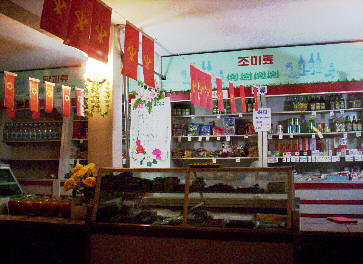 |
Personal opinions on these matters remain unspoken - in fact, in a tightly-insulated state that has fostered a uniquely collectivist mindset for well over half a century, personal opinions may not even exist. So interviews – on the rare occasions that they were granted – proved frustrating.
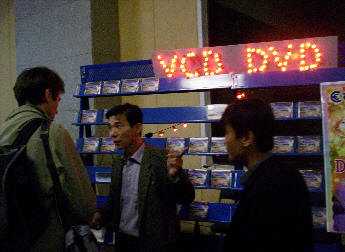 |
Take the wage issue. With reporters keen to gauge peoples’ earnings, we asked at
an embroidery collective. We were told the basic wage is 2,000 won, but most
workers take home around 3,000 won – although, during busy periods they can make
up to 30,000 won. Lesson: There is a certain amount of incentivization going on.
OK, we were getting somewhere – or were we? The next day, a second group of
reporters who asked the same questions to the same workers at the same
collective were told the basic was 10,000 won. Even the museums, in the words of Dr. Andrei Lankov, the Seoul-based Russian author, academic and former resident of Pyongyang who led the group, “are designed more to showcase the activities of the Leaders on their visits to the museums, than the objects being exhibited.” |
Indeed. In the embroidery collective, there was a diagram illustrating Kim Il-sung’s footsteps around the building during one of his famed visits to give “on the spot guidance.”
|
Even so, the trip was not simple ticket punching (“North Korea? Oh yeah, been
there, done the story….”). Observations proved rewarding. A convoy of perhaps 50 military trucks lined up along one road as we drove into Pyongyang – the closest thing we experienced to a traffic jam - from the airport were loaded with boxed television sets. Gifts to the boys from the regime’s leadership, this was the “military first” policy in action. Pyongyang may be a showcase, but it is not rich. The only district with adequate street lighting is the foreign compound, and the public spaces of even the finest monuments, such as the bowels of the Juche Tower, stink of stale urine: Chemical disinfectants are strangers to local toilets |
|
In the city, street-side kiosks, selling soft drinks, flowers, snacks,
photography services, etc, are if not ubiquitous, not uncommon. Ground-level
entrepreneurialism is taking hold, even if the organizational/ownership
structures are unclear. EU diplomats reported that markets and department stores
were packed, although we were not allowed near them.
In the countryside, the hillsides had been stripped for fuel, and they remain
un-terraced – meaning disastrous floods and resultant famines could recur if
heavy rains again flush the topsoil into the paddies below. Bloomberg’s Bradley
Martin, author of the encyclopedic tome “Under the Loving Care of the Fatherly
Leader,” who first ventured North in 1979, noted that the only change he could
see in the countryside was an almost total lack of mechanization.
Outside the city – we took a day trip to the southern city of Kaesong, just
north of the border – the poverty is shocking. Many of the rural houses lacked
window panes; their concrete was cracked and/or crumbling. We drove for over two
hours on the southern highway, during which time we counted a grand total of
four buses, three minibuses, four tractors, four trucks, one car and one
motorcycle – along with numbers of people, singly and in small groups, walking
the road with no clear destinations in sight. And this area is the rice bowl of
North Korea, one of the more affluent parts of the nation.
Even in Pyongyang it is clear that all is not well. Outside a flower exhibition
(inevitably, of “Kim Il-sungia’ and “Kim Jong-ilia”) we spotted a large group of
short statured young people with weather-beaten faces, dressed in rough, serge
uniforms. Our interpreters would not allow us near them and photographs were
forbidden; we surmised they were a group of construction workers or military
auxiliaries from the provinces, bussed in on a once-in-a-lifetime visit to the
wonders of the capital.
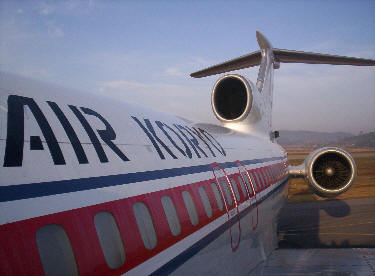 |
However, in the rare moments of unscripted contact, it was clear that North
Koreans are not the robotic communist Taliban of myth. They are a proud, warm,
kind-hearted people. While the faded facilities of the Koryo Hotel did not live up to the billing of a five star hotel, service proved excellent: Waitresses were happy to pose for photographs, and the bar girls in the microbrewery served as late as customers were drinking. Nothing was too much trouble. When it came to assisting foreigners in distress, locals went to lengths one would not expect elsewhere. Charles Whelan, AFP’s Seoul bureau chief, found himself in need of assistance in transit from Beijing to Pyongyang. A dual passport holder, he was not permitted to pass through China emigration as his entry stamp was on a separate passport – one he had packed in his onboard luggage. |
Consternation. An Air Koryo staff member, overhearing the conversation, rode to the rescue. He shot off, to return, minutes later, pouring sweat and lugging the case, which he had retrieved from the belly of the Air Koryo Ilyushin.
On my last night, I discovered I had left my notepad in a restaurant. We had a later appointment, but, with minutes to spare, an interpreter and I dived into a taxi – which was halted for an illegal turn by a policeman standing in the shadows of the (otherwise totally deserted) street. But once this foreigner was spotted inside, we were waved on. In the restaurant, three locals were sitting waiting patiently for us, pad in hand. (I am glad they didn’t/couldn’t read my notes, though…)
|
So after a half century of division, are North Koreans recognizably Korean?
Yes. As regards appearances, Pyongyangites appear well fed – in five days I
noticed only two (moderately) overweight locals – and reasonably well dressed:
Shabby clothing is as rare in Pyongyang as it is in Seoul. For men, black Mao
suits are a la mode, while the more daring cadres affect the style of the Dear
Leader, sporting his idiosyncratic zipper suits, shades and trademark bouffant.
Others wear tunics cut from what is clearly high-quality cloth. All the
best-looking girls wear uniforms: soldiers, traffic wardens, museum attendants,
immigration officials. But in stark contrast to fashion-crazy Seoulites,
Northerners appear to have little taste for international apparel brands, and no
youth fashion is visible. |
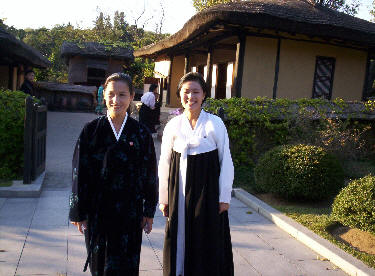 |
Tellingly, South Koreans’ spatial insensitivity - be it switching lanes in
traffic or shouldering aside passersby on sidewalks - is replicated in
Pyongyang. Despite the small number of automobiles, drivers constantly hit their
horns as nonchalant pedestrians cross ahead of them without a glance left or
right.
Clearly, North Koreans share many characteristics - passion, sense of humor,
kindness, frankness, communal mentality, pride, xenophobia, excessive loyalty to
authority figures – with their southern brethren. All of which suggests that
Koreans’ native attributes may have been amplified, rather than diminished,
through the communist lens
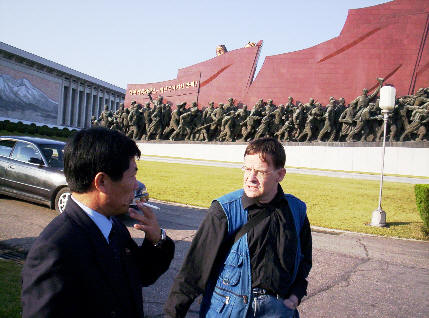 |
Even so, it is impossible to avoid the conclusion that North Koreans are
propagandized to the nth degree.
Take our formidable minder – Choe Jong-hun, 50, an officer with the
quasi-diplomatic Committee for Cultural Relations with Foreign Countries. Lankov
surmised he was a former state security employee who had been put out to graze
in a position where he could earn some foreign currency. Buttressing Lankov’s
analysis, Choe proudly showed this reporter a number of scars he said came from
unarmed combat training - not the kind of qualifications most PR minders in the
West can boast. Choe was, in many ways, a splendid fellow. He was certainly ever averse to putting on a show. Purple-faced, finger-wagging, table-thumping diatribes against Washington were his specialty: on our first night in the bar, with a beer in front of him, he ripped off his shirt, slapped himself on his (vest-covered) chest and bellowed: “Alright! Ask me anything!” |
An impromptu – and very lively - press conference followed. In possible his finest moment, he threatened to hurl a female journalist off the bus when she had the temerity to ask if a female could ever succeed the “Dear Leader.”
But he was personable: In a quiet moment he wondered aloud what on earth he had
down to deserve the job of hosting 17 unruly reporters for five days, and on our
last night, displayed a musical bent, crooning melancholy folk tunes at the
karaoke. In short, he was a classic ajoshi. If he could convert his righteous
indignation at “evil Americans” into ire at, say, “evil American investment
funds,” he could find a comfortable niche behind any Seoul editorial desk or
taxi wheel.
Our three, 20-year old female interpreters were a different proposition. All
were students of English. All came from elite families. One was the daughter of
a general. Another was the granddaughter of the commander of North Korean troops
in Panmunjom at the time of the infamous ax murders of U.S. servicemen. A third,
Lankov discovered, was the granddaughter of the very man who had founded Kim Il-sung’s
secret police. As far as appearances went – with their modern hairstyles and
make up, their smart blouses and skirts - they could each have fit into a Seoul
PR agency.
|
None had heard of The Beatles or Elvis Presley; one knew of Britney Spears.
Another evidenced astonishment when informed that Seoul was not composed
entirely of one-story homes. They were impressed by the storage capacity of
iPods, but less so by The Strokes. All expressed enormous interest in family
photos. None of that was particularly surprising. What was, was their lack of knowledge about Cold War incidents. When we asked the granddaughter of the Panmunjeom commander about the murders, she first told us how proud she was of her grandfather (to her delight, I snapped her picture beneath a huge photograph of grandpa meeting Kim Jong-il at a museum in the DMZ). And how what he had done was clearly the right thing. Unfortunately, she was hazy about what had actually happened. “Was anyone hurt in the incident?” she asked us quietly in the bus on our last day as we drove to the airport on our last day. |
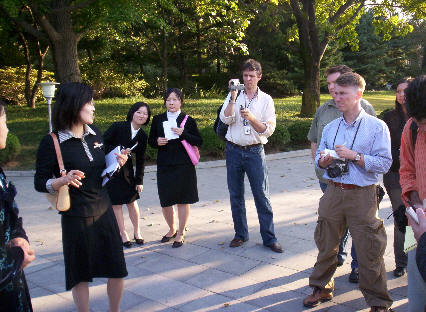 |
Throughout, it was pretty clear who was in charge. It was quite a sight to see a
hoary old hack like CBS Radio’s Don Kirk – a man who has fearlessly covered the
Vietnam War, as well as disasters and political and economic crises too numerous
to mention - being ordered around by a 20-year old lass. “Can we take pictures?”
Don enquired innocently at one stop. “You may not!” barked the girl in reply.
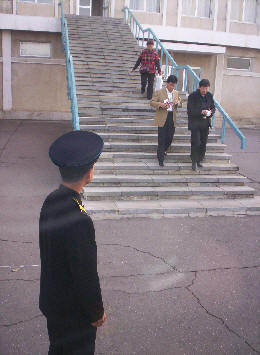 |
It has become one of the great clichés of modern journalism: The DMZ separating
the two countries is “the world’s tensest border,” “Asia’s last Cold War
flashpoint,” “the bamboo curtain…” Well yes – on the southern side. Author (and
former SFCC president) Mike Breen calls the area just south of the border “like
a Spielberg movie set” and it is - complete with real military bases, artillery
emplacements, “dragon’s teeth” tank traps, minefields, bunkers and dug-in armor. Not so on the “enemy” side. On the pleasant autumn day we visited, the northern half of the DMZ offered a remarkably relaxed contrast to the tense atmosphere visitors to the Southern side will be familiar with. There are none of the tank traps, artillery emplacements, minefields and bunkers ones sees as one drives North from Seoul - just one removable iron barrier on the road leading to the border, manned by a sleepy group of soldiers. In and around the truce village of Panmunjom, there is virtually no sign of military activity – indicating that the North’s army does not fear an invasion, so is not employed in a defensive posture, or (more likely) is so superbly camouflaged and so deeply dug in that it is invisible. |
The few North Korean soldiers stationed here saunter around casually – a marked contrast to the rigidly threatening postures of the South Korean sentries a few meters away across the demarcation line. Unlike the Brigade-of-Guards-style personal equipment of the Southern troops at the border, the Northern lads seemed strangers to spit and polish. When the colonel in charge of the area spotted the Financial Times’ Anna Fifield, who had visited a month earlier, he called her over for a celebratory photo and a chinwag on unification-related issues.
|
But beyond small talk, one can’t get much out of the military or the cadres who
are pretty well the only people one gets to mix with. The Koryo Hotel’s bar is a popular hangout for nuclear diplomats, spook wannabes, aid workers and visiting businessmen. Appropriately, it has a Casablanca-type ambience as cadres and foreign visitors mingle guardedly over the (excellent) house-brewed ale. But officials remain skittish, even when off duty. After 10 minutes of small talk, a young, obviously high-ranking cadre who had studied in the United Kingdom left our table with a polite smile once he realized we were journalists. Minutes later, his guest, an American planning a charity project, received a phone call. He returned, mumbled apologetically, “You guys are persona non grata” and left. We later saw them ensconced at another bar in the hotel. |
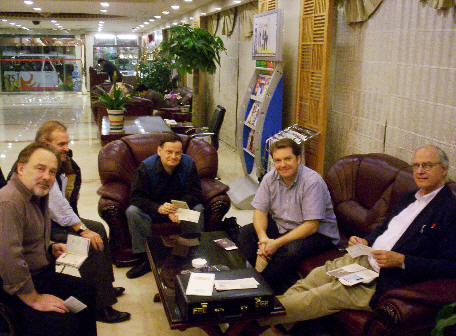 |
Invariably, members of Pyongyang’s expatriate community proved the best sources; the foreign community bar in the heart of the diplomatic compound had something of a “siege of the legations” atmosphere. Briefings from diplomats and comments from aid workers and visiting businessmen provided the best hard information we came by.
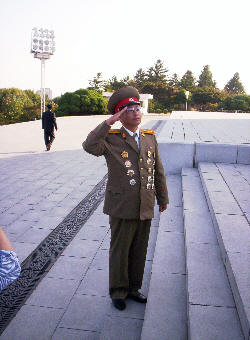 |
In terms of “headline stories” we caught no glimpse of anti-regime activity, got nary a whiff of the gulag, and saw not a single nuclear missile. Nor – alas! - was any member of our party granted an exclusive face-to-face with Kim Jong-il. But there was one moment when a scoop looked imminent. Our first stop after the airport was the giant Kim Il-sung monument that sits on a hilltop gazing majestically over Pyongyang down to the river. Just before our tour bus stopped, Mr. Choe told us in no uncertain terms: “No photos without permission! No on-the-spot interviews!” Understood. As we wandered around the area, photographing the statuary and the odd visiting local, a group of military officers approached. In halting Korean, I asked a colonel if a, er, photograph or two would be, ahem, permissible - with, naturally, the comrade colonel’s gracious permission, or, er...? “Of course!” he beamed - then insisted on striking a pose: Standing at the salute in front of the monument as I aimed and shot. Others rushed over and clicked away. |
|
It was an opportunity too good to miss. Time magazine’s Seoul bureau chief, Don Macintyre, dragged over an interpreter and asked: “Colonel, can you live in peace with the United States?” The colonel answered with the usual blah – then flabbergasted all present by adding, “And you know, we don’t have any nuclear weapons!” By this point, our minder was standing behind the garrulous colonel, frantically making cutting motions - “Stop talking!” – with his hands. But the man was in full flow: it would take something more formidable to stop him now. That something – actually, someone – was at hand. A bemedalled older woman waddled over. “My mother!” the colonel announced with a proud flourish. The old duck took a firm grip on her son’s upper arm and determinedly dragged him off. |
 |
But as for the nukes - could we take the good colonel’s word for it? His
forthright comments were quotable, and in a burst of international solidarity,
he had given his name. His shining red face had even been captured on a dozen
cameras. The only problem was, it had become clear by this time that the good
colonel was plastered.
Nobody had it in their hearts to report what he had said. The thought of the
cheery chap sitting in the gulag nursing a hangover for the next 10 years for
the sin of granting reporters a snap interview in an unguarded moment was too
much.
Of course, a worry was getting back in again after we filed our pieces. After all, we all assumed that, given North Korea’s propensity for Big Brother behavior, our articles would be monitored, and Mr. Choe had repeatedly warned that anyone who produced negative material would never, ever, ever, get into North Korea again.
|
However, this may be an empty threat. Several of the reporters on the trip had,
in fact, been before, and had written “objective” pieces. Yet they got back in.
North Korea’s lack of IT, bureaucratic stove-piping and dearth of coordination
between different bodies, presumably stifles the dissemination of information,
meaning a reporter who is blacklisted by one official body can still be invited
in by another (which will be happy to accept his valuable foreign exchange.) Of course, some journalists felt that it would help to have been a little bit economical with the truth when putting one’s affiliation down on their applications for the trip. A certain reporter - whose name I will not disclose, so as not to get Don Kirk’s put on Pyongyang’s blacklist - successfully applied for the visit under the label of a teacher at “The School of Hard Knocks.” |
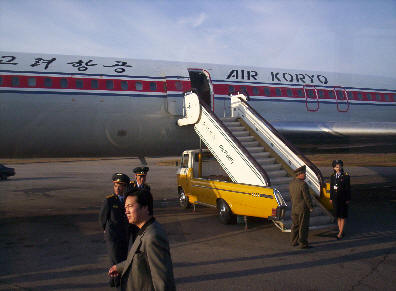 |
After the trip, and upon return to Seoul, I was in depression for days. Not only
does Pyongyang cast a strange spell, the fact that one may, just may, never be
permitted to return makes it unlike any other 21st century destination. Given
this, the pain of separated families must be unbearable.
We didn’t get the big story – but the trip was worth it. When covering a place,
there is no substitute for being there, and the many on-ground observations were
invaluable: I ended up filing around a dozen stories subsequent to the trip -
this piece, five months later, being the final one. Now, when I write of North
Korea, I have a more intimate grasp of “what it’s like;” that critical “feel” of
a place.
Oh, and that midnight walk? All I saw was a sleeping city - but I still wonder
about that loudspeaker. Is surveillance truly 24 hours - or was some nameless
joker simply keen to practice his English?
Back to ![]() Special Tours for Journalists in April-May
2007
Special Tours for Journalists in April-May
2007
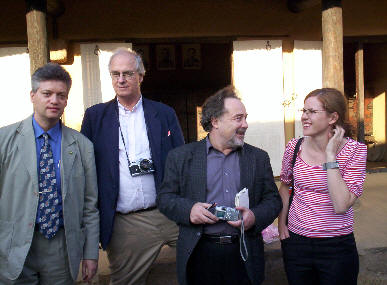
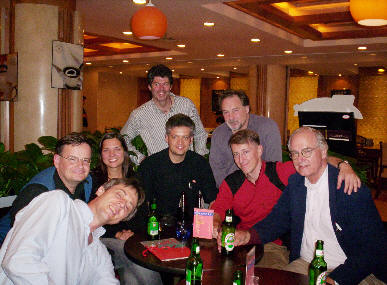
If you need more information about special tours to North Korea for journalists, please contact us using the following address: LJinfo@narod.ru
